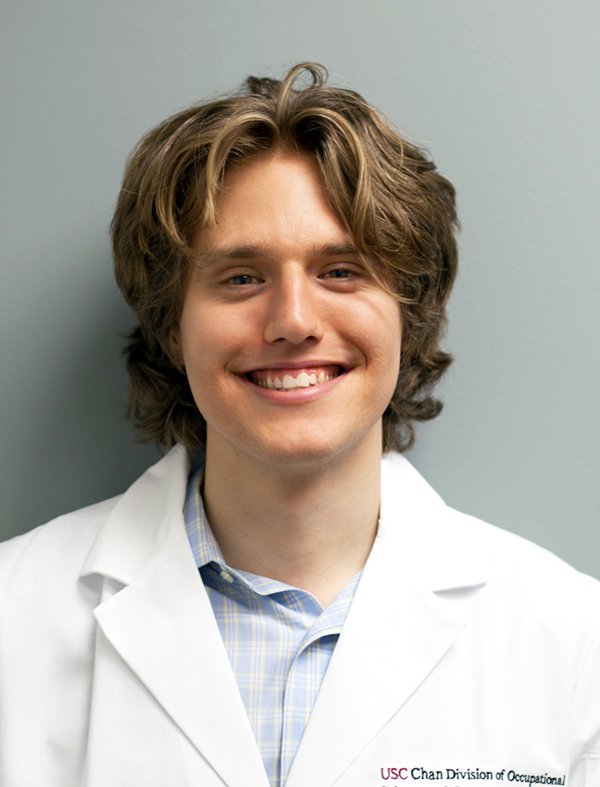Meet our new students: Auston Stamm MA ’17
August 27, 2015
In advance of the USC Chan Division’s 2015 White Coat Ceremony on Friday, Aug. 28, we’re profiling three of the newest Trojan Family members: incoming occupational therapy students. For our final installment, meet Austom Stamm MA ’17
Diversity, Access, Equity Events Students
By John Hobbs
Auston Stamm MA ’17 knows firsthand the impact an occupational therapist can have on the life of someone struggling with everyday tasks.
Born with mild cerebral palsy, Stamm, 25, has been seeing an occupational therapist since he was first diagnosed with cerebral palsy at 5 years old.
“Occupational therapy really changed my life,” Stamm says. “I would not have been able to succeed without it.”
At Friday’s 2015 White Coat Ceremony, Stamm’s success will be on full display as the young man, who once struggled with seemingly simple tasks, becomes one of the 205 USC Chan students to put on their white coats for the first time as occupational therapy students.
Finding His Own Way
It first became apparent that Stamm was different from other children after his grandmother began noticing that he had difficulty sitting up straight at the dinner table and struggling to use a fork. An MRI confirmed grandma’s suspicion that Stamm wasn’t just “gawky,” as his parents had believed. He had cerebral palsy.
While 80 percent of cerebral palsy cases in the United States are classified as hypertonic, characterized by spastic movements and extremely stiff muscles, Stamm was diagnosed with hypotonic cerebral palsy. This less prevalent type of cerebral palsy causes limp and weak muscles, which can give the individual a so-called “rag doll appearance.” They might have a tough time holding their head upright, standing and walking without assistance or maintaining proper posture.
As an elementary school kid, Stamm had trouble writing, using scissors and glueing together art projects. He also struggled (and still does) with some cognitive impairments caused by his cerebral palsy: difficulty remembering faces — he tries to remember people by their hairstyles or their voices — and even places — he relies on a GPS to navigate his way through the city, even to places he’s been many times before.
The condition made school tough for Stamm; he remembers being bullied in fourth grade after a teacher told the class they had to wait for Stamm, who had difficulty writing, to copy all the notes from the chalkboard before they could go to recess. When taking tests, Stamm could only get through half the questions in the allotted time, causing his grades to plummet. He says his mother was a fierce advocate for his education, putting him in a school for gifted students with learning disabilities and enlisting occupational and speech therapists to put her son on a better path.
With occupational therapy interventions, Stamm began adopting and adapting techniques and strategies to pass courses, including rapping his book reports. (Fun fact: Mel Gibson, whose son went to school with Stamm, once complimented Stamm’s rapping skills at a parent’s day where Stamm “performed” his report.) Instead of making posters or dioramas for class, he made movies, casting his friends and family members and learning how to edit film using professional software by fifth grade.
When it came time to choose a career path, TV and film seemed to be a perfect fit. He earned a bachelor’s degree from Loyola Marymount in cinematography and film/video production in 2012 before going on to work for a production company for six months editing film trailers.
“Tricking people into seeing really bad movies wasn’t the most meaningful thing,” recalls Stamm, who began the process of soul searching for the ideal career.
Helping Others Find Their Way
Remembering a film he made as an undergrad about students with learning disabilities, Stamm began to realize he wanted a career where he could help others the way he had been helped. He contacted his childhood occupational therapist for advice and began shadowing occupational therapists in 2013 to get a better understanding of the profession.
“It was so inspiring to be in the room as these patients’ lives were being transformed,” Stamm says. “It reminded me of how far I’ve come and how I’d like to be able to give back.”
Stamm applied to several occupational therapy programs but chose USC Chan because he liked how welcoming it was of students with disabilities (he had the opportunity to speak with the late Dr. Neville-Jan and felt inspired by her story), how much scientific inquiry and discovery took place in the division, and, he says, it doesn’t hurt that USC Chan is the U.S. News & World Report’s top-ranked occupational therapy institution in the nation.
With the division’s annual White Coat Ceremony just one day away, Stamm credits his mother for her constant advocacy and for never giving up on him. He also feels really excited to be able to put on that white coat and take the professional oath of an occupational therapist.
“It’s like being at a fancy restaurant and the waiter pulls back the dome to reveal what’s for dinner,” he says. “I can’t wait to see even more from occupational therapy and help others the way I’ve been helped by occupational therapy.”
⋯
Next by tag Diversity, Access, Equity ⟩ Events ⟩ Students ⟩






